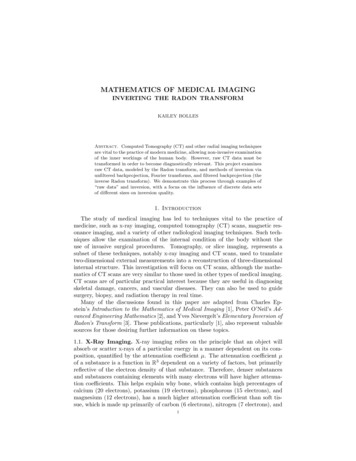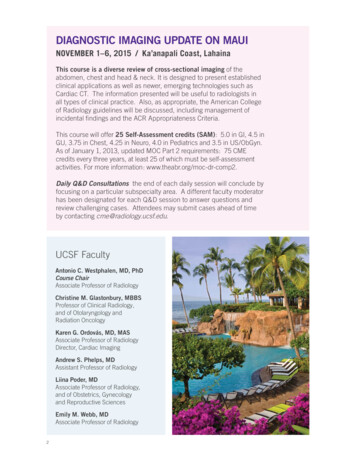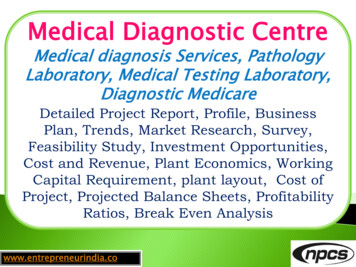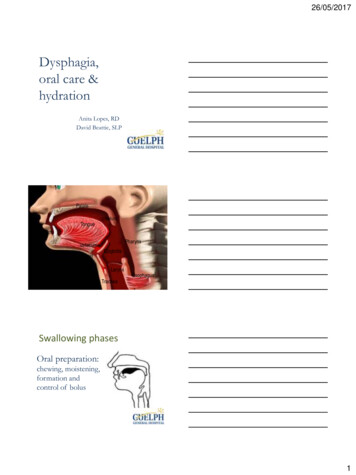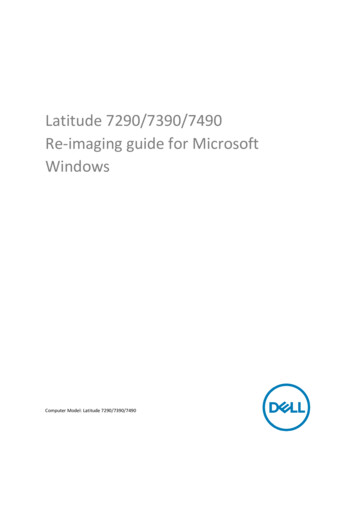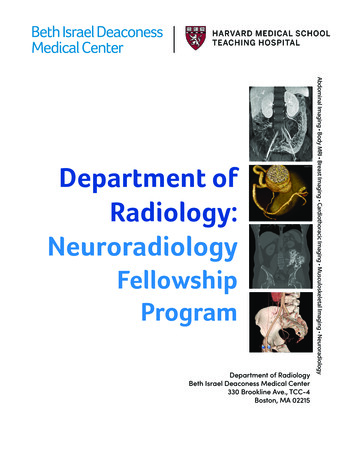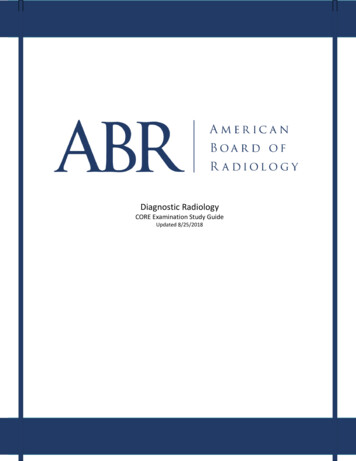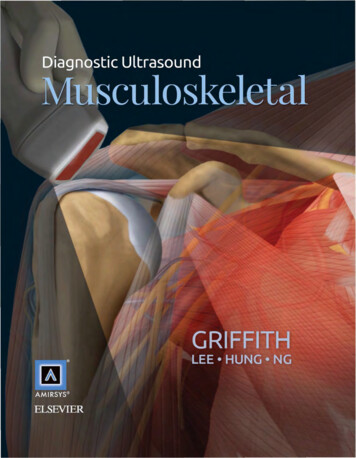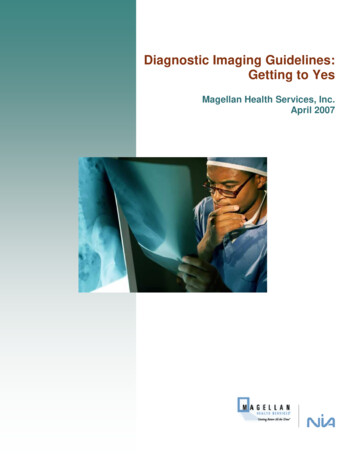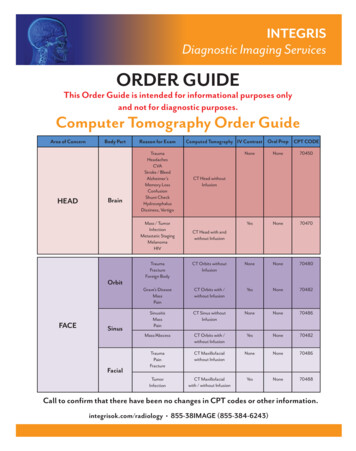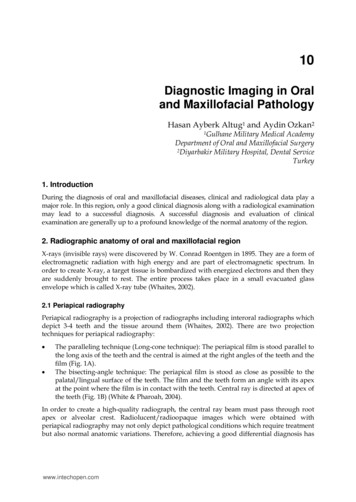
Transcription
10Diagnostic Imaging in Oraland Maxillofacial PathologyHasan Ayberk Altug1 and Aydin Ozkan21GulhaneMilitary Medical AcademyDepartment of Oral and Maxillofacial Surgery2Diyarbakir Military Hospital, Dental ServiceTurkey1. IntroductionDuring the diagnosis of oral and maxillofacial diseases, clinical and radiological data play amajor role. In this region, only a good clinical diagnosis along with a radiological examinationmay lead to a successful diagnosis. A successful diagnosis and evaluation of clinicalexamination are generally up to a profound knowledge of the normal anatomy of the region.2. Radiographic anatomy of oral and maxillofacial regionX-rays (invisible rays) were discovered by W. Conrad Roentgen in 1895. They are a form ofelectromagnetic radiation with high energy and are part of electromagnetic spectrum. Inorder to create X-ray, a target tissue is bombardized with energized electrons and then theyare suddenly brought to rest. The entire process takes place in a small evacuated glassenvelope which is called X-ray tube (Whaites, 2002).2.1 Periapical radiographyPeriapical radiography is a projection of radiographs including interoral radiographs whichdepict 3-4 teeth and the tissue around them (Whaites, 2002). There are two projectiontechniques for periapical radiography: The paralleling technique (Long-cone technique): The periapical film is stood parallel tothe long axis of the teeth and the central is aimed at the right angles of the teeth and thefilm (Fig. 1A).The bisecting-angle technique: The periapical film is stood as close as possible to thepalatal/lingual surface of the teeth. The film and the teeth form an angle with its apexat the point where the film is in contact with the teeth. Central ray is directed at apex ofthe teeth (Fig. 1B) (White & Pharoah, 2004).In order to create a high-quality radiograph, the central ray beam must pass through rootapex or alveolar crest. Radiolucent/radioopaque images which were obtained withperiapical radiography may not only depict pathological conditions which require treatmentbut also normal anatomic variations. Therefore, achieving a good differential diagnosis haswww.intechopen.com
216Medical Imagingan utmost importance. 10 periapical radiographs, 5 of them for the upper jaw and 5 of themfor the lower jaw, are applied for kids, whereas 14 periapical radiographs, 7 of them for theupper jaw and 7 for the lower jaw, are applied for the adolescents, performed using theparalleling technique (Fig. 2). It needs to different projection angle to capture third molar.During the creation of periapical radiographs, film holders might be used in order tocomply with standardization. However, free-handed positioning may also be preferred(Wood et al. 1997; Pasler, 1993).(a)(b)Fig. 1. (a) The paralleling technique; (b) The bisecting-angle technique.Fig. 2. Periapical radiographic survey for adolescents.Indications: Evaluation of periapical and periodontal tissue healthBefore, during and/or after surgical and endodontic treatmentsAssessment of the teeth and adjacent tissue after traumaEvaluation of apical pathology within the alveolar boneTo clarify of the presence/absence of unerupted teeth (Whaites, 2002).www.intechopen.com
Diagnostic Imaging in Oral and Maxillofacial Pathology2172.1.1 Anatomic landmarks of periapical radiograph2.1.1.1 MaxillaMaxillary anterior regionCervical dentin of the anterior teeth is penetrated in its lateral aspects by the X-ray beam. Itis seen in the radiograph as a radiolucent image which is known as “burn-out effect”. Theanterior portions of the nose and the median suture can also be seen clearly in theradiographs taken from maxillary anterior region (Fig.3A).Maxillary canine regionThis projection exhibits a nasal process of the maxilla and the nasal soft tissues.Nasopalatine canal, incisive foramen and anterior lobe of the maxillary sinus can also bevisible in this projection (Fig.3B).Maxillary premolar regionThe radiographs which were taken from premolar region exhibit the floor of the nasal cavityand maxillary sinus, usually separated from septum above the root tip of the secondpremolar (Fig.3C).Maxillary molar regionThe radiographs which were taken from premolar region exhibit maxillary sinus, maxillarytuberosity, and usually the body of the zygoma. Sometimes the process of the palatal bone,the pterygoid process and coronoid process of the mandible, so-called ‘’radix relicta’’ appearin the radiograph (Fig.3D) (Pasler,1993; Pasler&Visser, 2003).Fig. 3. A: Periapical view and schematic drawing of maxillary anterior region B: Periapicalview and schematic drawing of maxillary canine region C: Periapical view and schematicdrawing of maxillary premolar region D: Periapical view and schematic drawing ofmaxillary molar regionwww.intechopen.com
218Medical Imaging2.1.1.2 MandibleMandibular anterior regionThe radiographs which were taken from the anterior region exhibit 4 mandibular incisorteeth, mental fovea which shows a radiolucent outfit, vascular canals and the chinprominence. Burn-out effect may also be observed in this radiograph just like in theradiographs which were taken from the maxillary region (Fig. 4A).Mandibular canine regionThe radiographs which were taken from this region do not exhibit any important anatomicformation. Depending on the radiographic angle, mental foramen and enostosissurrounding it can be seen (Fig.4B).Mandibular premolar regionThe radiographs which were taken from premolar region exhibit mental foramen betweenthe roots of the premolar, course of mandibular canal and sublingual fovea. Depending onthe radiographic projection angle, mental foramen may lead to diagnostic problem. It maybe seen as a periapical lesion (Fig.4C).Mandibular molar regionThe radiographs which were taken from molar region exhibit mandibular canal, mylohyoidline, external and internal oblique line (Fig.4D) (Pasler,1993; Pasler&Visser, 2003).Fig. 4. A: Periapical view and schematic drawing of mandibular anterior region B: Periapicalview and schematic drawing of mandibular canine region C: Periapical view and schematicdrawing of mandibular premolar region D: Periapical view and schematic drawing ofmandibular molar regionwww.intechopen.com
Diagnostic Imaging in Oral and Maxillofacial Pathology219Legends for Figure 36.37.38.39.40.41.Alveolar boneAnterior nasal spineBurn-out effectCoronoid processGenial tubercleIncisive foramenInfeior nasal conchaLateral fossaLingual foramenMandibular canalMandibular tooth 1, central incisorMandibular tooth 2, lateral incisorMandibular tooth 3, canineMandibular tooth 4, first premolarMandibular tooth 5, second premolarMandibular tooth 6, first molarMandibular tooth 7, second molarMandibular tooth 8, third molarMaxillary sinusMaxillary sinus recessionMaxillary sinus septumMaxillary tooth 1, central incisorMaxillary tooth 2, lateral incisorMaxillary tooth 3, canineMaxillary tooth 4, first premolarMaxillary tooth 5, second premolarMaxillary tooth 6, first molarMaxillary tooth 7, second molarMaxillary tooth 8, third molarMaxillary tuberosityMental foramenMental fossaMental ridgeMiddle suture of hard palateMylohyoid ridgeNasal septumNasal cavityProcessus hamularisSoft tissue of noseSubmandibular fossaZygomatic arch2.2 Panoramic radiographyPanoramic radiography, also known as an orthopantomogram, is a panoramic scanningdental X-ray of the two-dimensional view of the jaws and their supporting structures fromear to ear. It is obtained with patient, whose head stands between X-ray generator and thewww.intechopen.com
220Medical Imagingfilm. The main advantage of panoramic radiography is the fact that it is clinically useful fordiagnostic problems associated with maxilla and mandible. One of the disadvantages of it isthat the images do not exhibit a fine anatomically detailed outfit gained from periapicalradiographs. Another problem related to orthopantomogram includes unequalmagnification (Lurie, 2004).Indications of panoramic radiographies are included in the following cases: Detection of the presence/absence of unerupted teethEvaluation of relationship of the upper posterior teeth with maxillary sinusEvaluation of relationship of the lower posterior teeth with canalis alveolaris inferiorSuspicion of asymptomatic swellingsRadiographic examination of temporomandibular joint disturbancesExamination of odontogenic, nonodontogenic cysts and tumorsEvaluation of alveolar crest for insertion dental implantsEvaluation of maxillomandibular region following traumaExamination of maxillary/mandibular surgical interventions2.2.1 Anatomic landmarks of panoramic radiographWhile evaluating panoramic radiographs, first of all, normal anatomic structure of theregion must be known well. Complicated structure of the regions, superposition of thesestructures and variations of the projection orientations may lead to problems during theevaluation process.There are four diagnostic regions in the panoramic radiography: Dentoalveolar RegionMaxillary RegionMandibular RegionTemporomandibular, Retromaxillary and Cervical Region.Dentoalveolar regionIt is surrounded by maxillary sinus and inferior border of the nasal cavity from above andmandibular canal from below. Frontal side of ramus takes place on its left and its right.The teeth which are located in the upper and lower jaws and alveolus supporting themare seen in this region. Caries, fillings and prostheses are evaluated for the teeth whereasperiodontal problems and intraalveolar pathologies related to the teeth are evaluated foralveolus (Fig.5).Maxillary regionIt is surrounded by orbita from above and maxillary sinus and the inferior border of thenasal cavity from below. Coronoid processus of the mandible and zygoma take place onits left and its right. Maxillary sinuses, zygomatic complex, nasal cavity and conchae,sphenoid, ethmoid, palate, frontal bones and pterygomaxillary fissure can be observed inthis region. Lefort fractures and maxillary sinus pathologies are evaluated in this region(Fig.5).www.intechopen.com
Diagnostic Imaging in Oral and Maxillofacial Pathology221Mandibular regionIt is comprised of the mandibular teeth and mandibula rather than alveolus. Condylar andcoronoid processes, ramus, body and angle and symphysis take place in this region.Mandibular canal, mental foramen, submandibular fossa, superimposed shadow of cervicalvertebrae, external oblique ridge, posterior surface of tongue, soft palate and uvula, floor ofnasopharynx and hyoid bone can also be observed in this region. Internal bone lesions andfractures are evaluated (Fig.5).Temporomandibular, retromaxillary and cervical regionIt is surrounded by temporal bone from above, and hyoid bone from below. Anterior of theramus of the mandible takes place in its anterior. Cervical vertebra takes place in itsposterior. The most important anatomic formation in this region is temporomandibular joint(TMJ). TMJ is comprised of glenoid fossa, articular eminence and articular process ofmandibular condyle. Cervial vertebra, ear lobe, soft palate and uvula, posterior pharyngealairway, floow of nasopharynx, zygomatic arch, styloid process of temporal bone,pterygomaxillary fissure and maxillary tuberosity can be observed in this region. Fracturesin this region are evaluated (Fig.5) (Lurie, 2004).Fig. 5. Panoramic radiograph with marked anatomic structuresLegends for Figure 5:1.2.3.4.5.6.7.Anterior nasal spineArticular tubercle of the temporal boneCervical vertebraCoronoid processDorsum of tongue (Shadow)Ear lobeEpipharynxwww.intechopen.com
4.25.26.27.28.29.30.31.32.33.Medical ImagingExternal auditory canalExternal oblique ridgeHard palateHyoid boneIncisive foramenInferior nasal conchaInferior border of mandibleInfraorbital canalMandibular angleMandibular canalMandibular condyleMaxillary sinusMaxillary tuberosityMental foramenNasal septumNasal cavityNasopalatine canalOrbital rimPterygoid process of sphenoid bonePterygopalatine fossaSigmoid notchSoft palateStyloid processSubmandibular fossaZygomaZygomatic arch2.3 Dental computed tomographyComputed tomography was discovered by Hounsfield in 1974. After improvements,nowadays, dental computed tomography is performed for diagnosis of oral andmaxillofacial pathology in most patients. Its advantage over 2D radiography is the fact thatit can eliminate the superimposition of images of adjacent tissues. Since it provides boneimages at the highest quality, it is the most widely used imaging technique (Curtain et al.,1998; Karjodkar,2006). Tomographic images are taken as trans-axial cross sections. Theseimages are stored on the computer and then recreated from the cross sections passingthrough the surfaces which are desired to be observed. This is called multiplanarreformation. This way, axial, sagittal and coronal planes of the material that was imaged canbe obtained. When these planes are combined by means of a software application, a 3Dimage may also be obtained. The images are obtained with the patient supine and duringquite respiration. Contrast agent injection may be needed to evaluate soft tissues. Whentaking a computed tomography of oral and maxillofacial region, images are acquired fromthe top of the frontal sinus to the sub mental region (Hermans et al., 2006). Computerizedtomography is used in maxillofacial surgery, reconstructive surgery, orthognatic surgery,dental implant applications, and detection of lesions like cyst/tumor, trauma andtemporomandibular joint diseases.www.intechopen.com
Diagnostic Imaging in Oral and Maxillofacial Pathology223Dental computed tomography has a number of advantages over other conventionalradiography: Undesired superimposition of other tissues in the region is eliminated.Thanks to the high-resolution of computerized tomography, differences between thetissues with different physical densities can be distinguished better. It is possible to obtain images of the tissues which are located on axial, coronalsagittal planes. It is especially a very useful tool for the planning of dental implant insertion. It has no magnification and no distortion. In the presence of formations like cysts/tumors, it can be determined whether thisformation has a solid or a liquid structure by means of density measurements(Frederiksen, 2004).Dental computed tomography has also disadvantages over other conventional radiography: Administration of contrast agent is necessary for imaging soft tissueMore radiation exposureDegradation of image quality by metallic objects, like as dental crown, fillings2.3.1 Anatomic landmarks of dental tomographyThis chapter presents the imaging of normal anatomic structures by dental tomography onaxial, coronal, sagittal planes and in 3D view (Fig.6,7,8).Fig. 6. 3D CT anatomy of the facial skeletonwww.intechopen.com
224Medical ImagingFig. 7. (A,B). Axial CT anatomy of the facial skeleton; (C,D). Axial CT anatomy of the facialskeletonwww.intechopen.com
Diagnostic Imaging in Oral and Maxillofacial Pathology225Fig. 8. (A,B). Coronal CT anatomy of the facial skeleton; (C,D). Coronal CT anatomy of thefacial skeleton; (E,F). Coronal CT anatomy of the facial skeletonFigure legends for figure 6,7,8:1.2.3.4.5.6.7.8.9.10.11.12.13.14.15.Anterior nasal spineCarotid canalConcha bullosaCoronoid processCrista galliDens axisEthmoid sinusExternal auditory canalForamen ovaleForamen rotundumFrontal boneFrontal sinusGenial tubercle of mandibleGlenoid fossaGreater palatine canalwww.intechopen.com
Medical ImagingGreater wing of sphenoid boneHamulus of medial pterygoid plateHard plateHyoid boneIncisive canalIncisive foramenInferior meatusInferior orbital fissureInfraorbital canalInfratemporal fossaLacrimal boneLateral pterygoid plateLesser palatin canalMandibleMandibular canalMandibular condyleMandibular foramenMandibular notchMandibular ramusMaxillaMaxillary sinusMaxillary tuberosityMedial pterygoid plateMental foramenMiddle meatusMiddle suture of hard palateNasal boneNasal cavity airwayNasal septumNasofrontal sutureNasolacrimal canalNasopharynxOrbitOropharynxParapharyngeal spacePerpendicular plate of ethmoid bonePterygoid fossaPterygoid process of sphenoid bonePterygopalatine fossaSphenoid boneSphenoid sinusSphenoid sinus septumSphenozygomatic sutureStyloid processSubmandibular spaceSubmandibular glandTongueTrigomun retromolareUvulawww.intechopen.com
Diagnostic Imaging in Oral and Maxillofacial Pathology22765. Vomer66. Zygoma67. Zygomatic arch3. Radiographic description of oral and maxillofacial pathology3.1 Radiolucent/radiopaque lesions of the jawsOdontogenic cysts and tumors present problems of diagnosis, radiology andhistopathology. In general, their differential diagnosis requires radiographic clinical data,since many of them possess similar histological characteristics. Radiologic appearance ofjaw cysts and odontogenic tumors varies considerably. The common lack of physicalfindings and the development of most of these lesions within the confines of the bonemake radiologic investigation and interpretation uniquely important. Radiographs arealso important in treatment planning for surgical removal. They can evaluateencroachment on vital structures, extent into soft tissue, size of the lesion, andrequirements for reconstruction. Radiography allows for creation of a radiologicdifferential diagnosis. (Escobar et al.,2007)3.1.1 Radiolucent lesions of the jaws Dental granulomaRadicular cystDentigerous cystKeratocystic odontogenic tumorAmeloblastomaIncisive canal cystSimple bone cystCentral giant cell granulomaOdontogenic myxoma3.1.2 Radiopaque lesions of the jaws ibrous dysplasia (late stage)3.1.3 Mixed radiolucent/radiopaque lesions of the jaws Fibrous dysplasia (early stage)Ossifying fibromaCemento-osseous dysplasiaChronic com
228Medical ImagingDentigerous cystDentigerous cysts are the second most common odontogenic cysts after radicular cysts. Itsurrounds the crown of an impacted tooth, caused by fluid accumulation between thereduced enamel epithelium and the enamel surface, resulting in a cyst in which the crownis located within the lumen and roots outside. It is usually asymptomatic but producessome swelling or pain when become large or inflamed. It is associated clinically withimpacted tooth most commonly an unerupted 3rd molar (mandibular- more thanmaxillary), then maxillary canines, rarely involve deciduous teeth. Radiographically, thedentigerous cyst appears as a unilocular radiolucency of variable size with well-definedsclerotic borders, associated with the crown of an unerupted tooth. In an infected cyst theborders may be ill-defined. The radiographic appearance of such a cyst, though quitetypical, is not diagnostic (Daley&Wysocki, 1995). The treatment of dentigerous cysts isdetermined by the size of the lesion. Small lesions should be removed by surgery; largercysts are treated by marsupialization or decompression. The possible complications of thedentigerous cysts are the permanent bony deformation from its expansive destruction ofbone, loss of essential permanent dentition or its innervation of the mandibular nerve.Dentigerous cysts with long evolution can present areas with keratin or dysplasic changesof its epithelial revetment with development of an ameloblastoma or an epidermoidcarcinoma (Fig.9) (Weber, 1993).Fig. 9. Panoramic radiograph shows a well-defined expansile radiolucent lesion in the rightmandible and unerupted right canine.Radicular cystRadicular cysts are the most common cyst of the jaws. They are most frequent between theages of 20 and 60 years. Radicular cysts may cause slowly progressive painless swellings,with no symptoms until they become expansion of the cortical plates. If the infection enters,the tooth and swelling develop all the painful symptoms of an abscess. Initially, the swellingwww.intechopen.com
Diagnostic Imaging in Oral and Maxillofacial Pathology229is rounded and hard. Later they are caused the demolition of cortical plate, than the swellingis rubbery and fluctuant because of the cyst fluid. Large cysts may involve a completequadrant with some of the teeth occasionally mobile and some additional pulps nonvital.Radiographically, radicular cyst appears well defined radiolucent area. Infection of a cystcauses resorption of the surrounding tissue. If the cyst extends slowly, a condensedradiopaque periphery is present. Enucleation is usual method for the treatment of radicularcyst. Larger cysts are treated by marsupialization (Fig.10) (Cawson&Odell, 2002; Wood etal.,1997; Sahin et al., 2009).Fig. 10. Radiographic appearance of the radicular cyst (maxillary right second molar region)on the panoramic radiographKeratocystic odontogenic tumorThe most recent classification of the World Health Organization (WHO) reallocatedkeratocyst (keratinized primordial cyst) within the classification of odontogenic tumoursunder the term “keratocystic odontogenic tumor.” It has specific histopathologicalfeatures and clinical behavior, it makes up to 10- 20% of all developmental odontogeniccyst (Barnes et al.,2005). Keratocystic odontogenic tumor occurs more in mandible 80%(posterior body and ascending ramus). It grows in anterior-posterior direction withinmedullary cavity of the bone without causing obvious bone expansion. This is useful todifferentiate clinical and radiographic dentigerous and radicular cyst of similar size whichproduce bone expansion. Multiple keratocystic odontogenic tumor is seen in nevoid basalcell carcinoma (gorlin syndrome). Radiographically, it is well defined radiolucent areawith smooth corticated margin. Large lesions in posterior body and ascending ramus ofthe mandible appear as multilocular radiolucency. An unerupted tooth is involved in thelesion in 25-40 % of cases. The treatment of keratocystic odontogenic tumor is completewww.intechopen.com
230Medical Imagingremoved by enucleation and curettage it has tendency to recurred because of friablenature of cyst wall that result in fragment or due to formation of new cysts from dentallamina (daughter cysts). Marsupialization has been effective in reducing the size of thecyst (Fig.11) (Mendes RA et al., 2010)Fig. 11. Panoramic radiograph shows an ellipsoid, expansile, well-corticated, radiolucentlesion in left mandibular body and ascending ramus.Lateral periodontal cystLateral periodontal cyst is rare asymptomatic lesion, mainly in mandible in canine-premolarregion. It is usually seen by chance in routine radiographs. Radiographically, it appears as awell circumscribed radiolucent area located laterally to the roots of vital tooth. Occasionallythis cyst appears as multilocular (poly cystic) named botryoid odontogenic cyst. Theradiographical picture is not diagnostic. Lateral periodontal cyst should be enucleated. If theaffected tooth is healthy, it can be retained (Fig.11) (Cawson&Odell, 2002).Fig. 12. Periapical view of lateral periodontal cyst A. Pre-treatment B. Post-treatmentwww.intechopen.com
Diagnostic Imaging in Oral and Maxillofacial Pathology231AmeloblastomaAmeloblastoma are most common tumors of jaws. The majority of ameloblastoma arebenign, with less than 1% showing malignant behavior. The most common site ofameloblastoma is the ascending ramus and proximal body of the mandible (80%). Basedon radiological appearance, ameloblastomas are divided into two subtypes. Multicysticameloblastomas account for approximately 85% of all ameloblastomas and occur in thethird to seventh decades of life. On radiographs, it is typically form rounded, cyst-like,radiolucent area appear multilocular. There is marked buccolingual cortical expansionwith internal osseous septae, giving rise to a “soap bubble” appearance. Toothdisplacement or root resorption may occur. Unicystic ameloblastomas occur in a youngerage group and tend to be non-invasive. They present as a well-circumscribed, unicystic,radiolucent lesion, mostly in the region of the mandibular third molar (DelBalso, 1998).Treatment is by wide excision, preferably taking up to 2 cm of apparently surroundingnormal tissue. Unicystic ameloblastomas can be enucleated with low risk of recurrence(Cawson&Odell, 2002).Fig. 13. Panoramic radiographic view of ameloblastoma of mandibular ramus.Central giant cell granulomaCentral giant cell granulomas (CGCG) typically occur in patients younger than 30 years ofage, more often in females. The lesion is more common in the anterior part of mandible witha tendency to cross the midline. In the early stage, the lesion manifests as a small unilocularlucent lesion. However, with development, it appears multilocular with fine trabeculae.They may cause a variable degree of bony expansion, divergence of roots and rootresorption. Brown tumour of hyperparathyroidism can mimic CGCGs radiologically as wellas pathologically; however, the patient’s age, radiological changes in other bones, andbiochemical findings help in differentiation (Altug et al., 2011b).www.intechopen.com
232Medical ImagingFig. 14. Panoramic radiographic view of CGCG of mandibula.OdontomaOdontomas are considered to be a hamartomatous lesion rather than a neoplasm. Mostcases are diagnosed in the second decade of life, and are usually associated with animpacted tooth. Radiologically, it is seen as a radiopaque mass surrounded by thinradiolucent space. The compound odontomas are composed of multiple well-formed teethwhereas the complex odontomas appear as an irregular calcified tissue. A related but veryrare lesion is ameloblastic fibro-odontoma. Most cases occur in young males involvingposterior jaws and may expand into the ramus. The amount of radiolucent internal structureexceeds the odontomas component (Weber et al., 1993; Altug et al, 2010b).Fig. 15. Panoramic radiographic view of odontoma of mandibular canine region.www.intechopen.com
Diagnostic Imaging in Oral and Maxillofacial Pathology233Ossifying fibromaOssifying fibroma is rare. It is slow expansile growth and it can expand the cortices and displaceadjacent structures. True benign tumors of mesenchyme are with strong predilection for toothbearing sections of jaw. Patients are usually females in 20-40s. Radiographically, early lesion isradiolucent with varying degrees of calcification and has well circumscribed margins. If thelesion is more opaque shows that the lesion is mature. The patterns of calcifications have noeffect on the lesions behavior. Small lesions should be removed by enucleation and curettage.However, large lesions (5mm margin) which have distorted the jaw require local resection.Recurrence is rare (Fig. 16) (Cawson & Odell, 2002; Ortakoğlu et al., 2006).Fig. 16. Axial CT view of maxillary ossifying fibromaCementoblastomaCementoblastoma is a benign neoplasm and forms a mass of cementum and cementum-liketissue on roots of teeth. It is usually affect of posterior region of mandible, especiallymandibular first molar. Clinically, cementoblastoma mainly affects young adults,particularly males. It is slow-growing and usually asymptomatic; but pain and swellinghave been reported in a number of cases. Radiographically, there is typically a radiopaquemass with a thin radiolucent margin with the root of the tooth. The mass may be rounded orirregular in shape. Resorption of related tooth’s roots is common, but the tooth remains vital(Fig.17) (Sumer M et al., 2006).www.intechopen.com
234Medical ImagingFig. 17. Panoramic radiographic view of cementoblastoma related to mandibular premolartooth.Focal osseous-dysplasiaThe current classification of fibro-osseous lesions, released in 2005 by the World HealthOrganization (Barnes et al.,2005), is based on age, sex and histopathologic, radiographic andclinical characteristics, as well as location of the lesion. Focal osseous dysplasia is anasymptomatic benign malformation and belonging to the group of fibro-osseous lesions.Although the etiology and pathogenesis of focal osseous-dysplasia are unknown,histogenetically it is believed that it originated from periodontal ligament. It usually appears indentate and/or edentulous posterior mandibular region. Radiographically, the lesion is welldefined by radiolucent borders and an unilocular dense radiopaque appearance. No treatmentis necessary for focal osseous dysplasia and follow-up is essential to confirm the diagnosis.Some authors have suggested that the transformation into florid cemento-osseous dysplasia ispossible and should be considered at recall visits (Fig.18) (Summerlin &Tomich, 1994).Fig. 18. Periapical radiographic view of focal osseous dysplasia in mandiblewww.intechopen.com
Diagnostic Imaging in Oral and Maxillofacial Pathology235Odontogenic myxomaOdontogenic myxoma derives from dental mesenchyme and generally affects the youngpersons (of average age 15 years). It usually affects in the mandible, and typically appearsin the mandibular angles. It has benign behaves but can infiltrate widely. Due to theinadequate surgical excision, it may recur. Radiographically, the odontogenic myxomamay produce several types: unicystic, multilocular, pericoronal and radiolucentradiopaque and it is close resemblance to soap bubble-like picture of ameloblastoma. Thelesion gives rise to fusiform swelling and radiolucent area with scalloped margins. Thetreatment of odontogenic myxoma is required wide excision but some cases have been seenover 30 years after the first intervention (Fig.19) (Cawson & Odell, 2002; Wood et al., 1997;Altug et al., 2011a).Fig. 19. Axial CT view of maxillary odontogenic myxoma.www.intechopen.com
236Medical ImagingSolitary eosinophilic granulomaSolitary eosi
2.3 Dental computed tomography Computed tomography was discovered by Hounsfield in 1974. After improvements, nowadays, dental computed tomography is performed for diagnosis of oral and maxillofacial pathology in most pati

